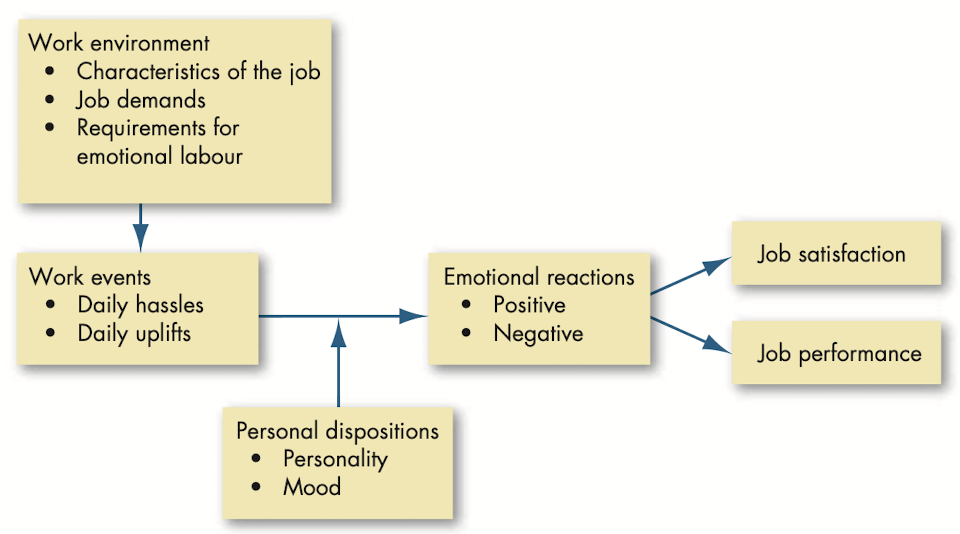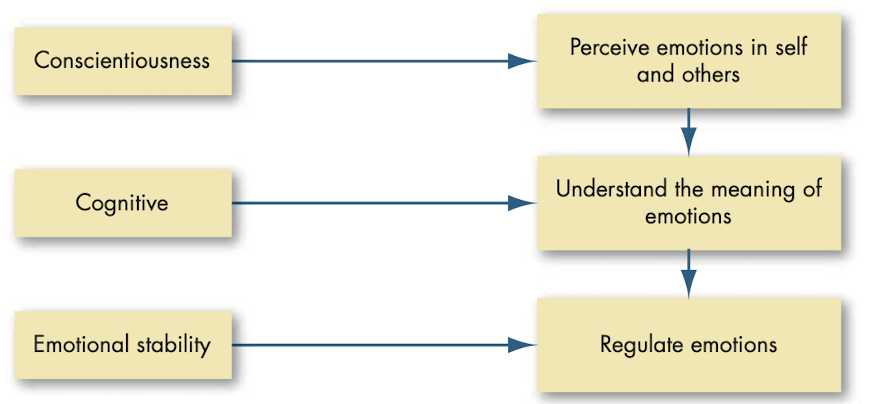
Chapter 8 - Emotions & moods
What are emotions and moods?
Affect: broad range of feelings that people experience.
Emotions: intense feelings that are directed at someone/something.
Moods: feelings that tend to be less intense than emotions and that lack a contextual stimulus.
Positive affect: mood dimension that consists of specific positive emotions such as excitement, self-assurance and cheerfulness at the high end and boredom, sluggishness and tiredness at the low end.
Negative affect: mood dimensions that consists of emotions such as nervousness, stress and anxiety at the high end and relaxation, tranquility and poise at the low end.
Positivity offset: tendency of most individuals to experience a mildly positive mood at zero input (when nothing in particular is going on).
Evolutionary psychology: area of inquiry which argues that we must experience the emotions we do because they serve a purpose.
Sources of emotions and moods
Personality
Affect intensity: individual differences in the strength with which individuals experience their emotions.
Time of the day
Day of the week
Weather
Illusory correlation: tendency of people to associate two events when in reality there is no connection.
Stress
Social activities
Exercise
Age
Gender
Emotional labour
Emotional labour: situation in which an employee expresses organizationally desired emotions during interpersonal transactions at work.
Emotional dissonance: inconsistencies between the emotions people feel and the emotions they project.
Felt emotions: individual’s actual emotions.
Displayed emotions: emotions that are organizationally required and considered appropriate in a given job.
Surface acting: hiding one’s inner feeling and forgoing emotional expressions in response to display rules.
Deep acting: trying to modify one’s true inner feelings based on display rules.
Affective events theory (AET)
Affective events theory (AET): model which suggests that workplace events cause emotional reactions the part of employees, which then influence workplace attitudes and behaviors.

Emotional intelligence (EI)
Emotional intelligence (EI): ability to detect and to manage emotional cues and information.

Emotion regulation
Strategies for emotion regulation and their likely effects
Being able to identify and modify the emotions you feel
Strategies include acknowledgement rather than suppressing our emotional response
Re-evaluating events as they occur
Venting is another technique (expressing emotions outwardly).
OB applications of emotions and moods
Selection → emotional intelligence (EI) is a factor that employers should consider when hiring especially when there is a high level of social interaction involved.
Decision-making → positive moods and emotions help when decision making, depends but a recent study says negative moods are worse when making decisions.
Creativity → people in good moods tend to be more creative than people in bad moods, they produce more original ideas, more flexible and open in thinking.
Motivation → organizations that promote positive moods are likely to have more motivated workers.
Leadership → effective leaders rely on emotional appeal to help convey their messages, expression of emotions in speeches is often the critical element that makes us accept or reject a leaders message.
Negotiation → negotiation is an emotional process, skilled negotiator has a “poker face”.
Customer service → workers emotional state influences customer service, influences level of repeat business and level of customer satisfaction.
Emotional contagion: process by which people’s emotions are caused by the emotions of others.
Job attitudes → people who have a good day at work tend to be in a better mood that evening at work.
Deviant workplace behaviors → violating established norms provoke negative emotions, people who feel negative emotions are more likely to participate in short-term deviant workplace behaviors.
Safety and injury at work → employers might improve health and safety by ensuring that workers are engaged in potentially dangerous activities when they are in a bad mood.
How managers can influence moods → managers can use humor and give their employees small tokens of appreciation for work well done.
Chapter 8 - Emotions & moods
What are emotions and moods?
Affect: broad range of feelings that people experience.
Emotions: intense feelings that are directed at someone/something.
Moods: feelings that tend to be less intense than emotions and that lack a contextual stimulus.
Positive affect: mood dimension that consists of specific positive emotions such as excitement, self-assurance and cheerfulness at the high end and boredom, sluggishness and tiredness at the low end.
Negative affect: mood dimensions that consists of emotions such as nervousness, stress and anxiety at the high end and relaxation, tranquility and poise at the low end.
Positivity offset: tendency of most individuals to experience a mildly positive mood at zero input (when nothing in particular is going on).
Evolutionary psychology: area of inquiry which argues that we must experience the emotions we do because they serve a purpose.
Sources of emotions and moods
Personality
Affect intensity: individual differences in the strength with which individuals experience their emotions.
Time of the day
Day of the week
Weather
Illusory correlation: tendency of people to associate two events when in reality there is no connection.
Stress
Social activities
Exercise
Age
Gender
Emotional labour
Emotional labour: situation in which an employee expresses organizationally desired emotions during interpersonal transactions at work.
Emotional dissonance: inconsistencies between the emotions people feel and the emotions they project.
Felt emotions: individual’s actual emotions.
Displayed emotions: emotions that are organizationally required and considered appropriate in a given job.
Surface acting: hiding one’s inner feeling and forgoing emotional expressions in response to display rules.
Deep acting: trying to modify one’s true inner feelings based on display rules.
Affective events theory (AET)
Affective events theory (AET): model which suggests that workplace events cause emotional reactions the part of employees, which then influence workplace attitudes and behaviors.

Emotional intelligence (EI)
Emotional intelligence (EI): ability to detect and to manage emotional cues and information.

Emotion regulation
Strategies for emotion regulation and their likely effects
Being able to identify and modify the emotions you feel
Strategies include acknowledgement rather than suppressing our emotional response
Re-evaluating events as they occur
Venting is another technique (expressing emotions outwardly).
OB applications of emotions and moods
Selection → emotional intelligence (EI) is a factor that employers should consider when hiring especially when there is a high level of social interaction involved.
Decision-making → positive moods and emotions help when decision making, depends but a recent study says negative moods are worse when making decisions.
Creativity → people in good moods tend to be more creative than people in bad moods, they produce more original ideas, more flexible and open in thinking.
Motivation → organizations that promote positive moods are likely to have more motivated workers.
Leadership → effective leaders rely on emotional appeal to help convey their messages, expression of emotions in speeches is often the critical element that makes us accept or reject a leaders message.
Negotiation → negotiation is an emotional process, skilled negotiator has a “poker face”.
Customer service → workers emotional state influences customer service, influences level of repeat business and level of customer satisfaction.
Emotional contagion: process by which people’s emotions are caused by the emotions of others.
Job attitudes → people who have a good day at work tend to be in a better mood that evening at work.
Deviant workplace behaviors → violating established norms provoke negative emotions, people who feel negative emotions are more likely to participate in short-term deviant workplace behaviors.
Safety and injury at work → employers might improve health and safety by ensuring that workers are engaged in potentially dangerous activities when they are in a bad mood.
How managers can influence moods → managers can use humor and give their employees small tokens of appreciation for work well done.
 Knowt
Knowt
